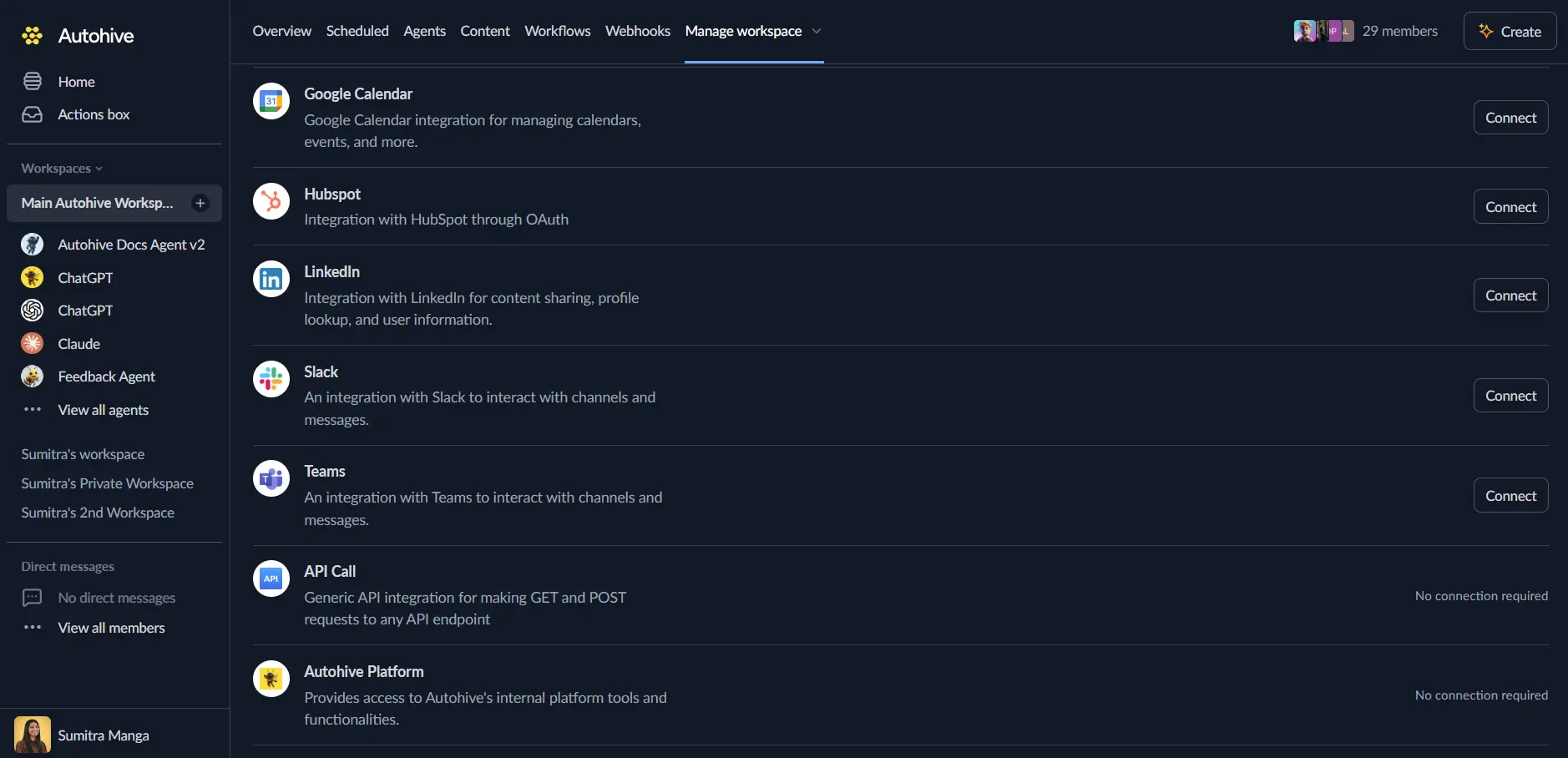Microsoft Teams
The Autohive Microsoft Teams integration connects your Teams workspace with Autohive’s automation platform, enabling:
- Channel management - List, search, and discover Teams channels across your organization
- Message automation - Send automated messages to specific channels for notifications and updates
- Channel discovery - Find channels by name or search criteria for targeted communication
- Team communication workflows - Automate routine messages, alerts, and status updates
- Cross-platform integration - Connect Teams with other tools in your automation workflows
Install the integration
-
Log in to Autohive and navigate to Your user profile > Connections or Your workspace -> Manage workspace
-
Locate the Microsoft Teams Integration card and click Connect

-
Select your Microsoft account and click Choose Account
-
Review and approve permissions. Autohive requests access to:
Ensure you approve the permissions required in order for the integration to function as expected.
-
Confirm installation - you’ll be redirected to Autohive with “Connected” status displayed
Use the integration
You can now use the integration with your agents, workflows and scheduled tasks!
- Follow our Create your first agent guide on how to create an agent.
- In the ‘Agent settings’, scroll down to the ‘Add capabilities’ section and turn on the Microsoft Teams capability. You can choose what individual Teams capabilities to turn on and off.
- Once the settings have been selected, begin prompting the agent of the workflow you’d like to achieve with Autohive and Microsoft Teams!
Available capabilities
Channel Management
- List Channels: View all Teams channels accessible to your account across the organization
- Search Channels: Find specific channels using search queries and name matching
- Get Channel by Name: Locate exact channels by their specific names for targeted operations
- Channel Discovery: Navigate your organization’s Teams structure efficiently
Message Operations
- Send Message: Post messages to specific Teams channels with automated content
- Automated Notifications: Deliver system alerts, status updates, and workflow notifications
- Scheduled Messaging: Send messages at specific times through Autohive workflows
- Multi-Channel Broadcasting: Send messages to multiple channels simultaneously
Team Communication Automation
- Workflow Integration: Connect Teams messaging with other platform integrations
- Event-Driven Messaging: Send messages triggered by external events or conditions
- Status Updates: Automate project status, deployment notifications, and system alerts
- Cross-Platform Coordination: Synchronize Teams communication with other business tools
Key features
Microsoft Graph API Integration
- Secure access through Microsoft’s official Graph API
- Enterprise-grade authentication and permission management
- Respect organizational policies and access controls
- Seamless integration with Microsoft 365 ecosystem
Channel Discovery and Targeting
- Efficient channel search across large organizations
- Name-based channel identification for precise targeting
- Support for team hierarchies and channel organization
- Quick access to frequently used channels
Enterprise Communication
- Support for organizational Teams structures
- Respect user permissions and access controls
- Integration with corporate Microsoft 365 accounts
- Compliance with enterprise security policies
Workflow Automation
- Event-driven message sending for system notifications
- Scheduled message delivery for regular updates
- Integration with other Autohive capabilities for comprehensive workflows
- Support for complex automation scenarios
Common use cases
Development and DevOps
- Send deployment notifications to development channels
- Alert teams about system issues or maintenance windows
- Share build status and testing results automatically
- Coordinate release communications across teams
Project Management
- Deliver project milestone updates to stakeholder channels
- Send deadline reminders and task notifications
- Share progress reports with team channels
- Automate meeting reminders and agenda sharing
Business Operations
- Broadcast company announcements to general channels
- Send automated reports to department-specific channels
- Share metrics and KPI updates with leadership teams
- Coordinate cross-departmental communications
Customer Support
- Send support ticket updates to internal teams
- Share customer feedback with product development channels
- Alert support teams about high-priority issues
- Coordinate escalation communications
Teams integration best practices
Message Content Guidelines
- Keep automated messages clear and professional
- Include relevant context and actionable information
- Use appropriate formatting for better readability
- Avoid spam-like or excessive automated messaging
Channel Targeting
- Send messages to appropriate channels based on content relevance
- Respect team preferences for automated notifications
- Use specific channels rather than general ones when possible
- Consider channel purposes and guidelines
Frequency and Timing
- Balance automation with human communication
- Schedule messages during appropriate business hours
- Avoid over-posting or flooding channels with automation
- Allow for manual override of automated messages
Disconnect the integration
Important: Disconnecting stops data synchronization but preserves existing data in both systems.
- Navigate to Your user profile -> Connections or Your workspace -> Manage workspace
- Find the Microsoft Teams Integration
- Click Disconnect and confirm
Data Impact: Existing data remains unchanged in both systems, but sync stops and Autohive loses Teams API access.
Uninstall the app
From Microsoft: Go to your Microsoft 365 admin center > Azure Active Directory > Enterprise applications > Find Autohive and remove access